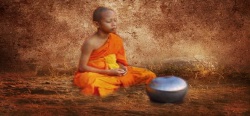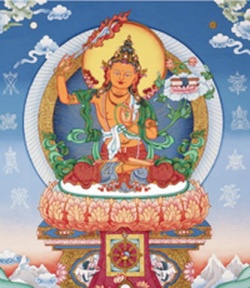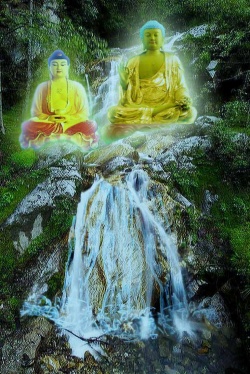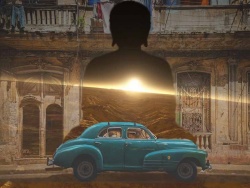Aura
In parapsychology and spiritual practice, an aura is a supposed field of subtle, luminous radiation surrounding a person or object like the halo or aureola in religious art.
The depiction of such an aura often connotes a person of particular power or holiness. It is said that all objects and all living things manifest such an aura.
Often it is held to be perceptible, whether spontaneously or with practice: such perception is at times linked with the third eye of Indian spirituality.
Various writers associate various personality traits with the colors of different layers of the aura. It has also been described as a map of the thoughts and feelings surrounding a person.
Skeptics such as Robert Todd Carroll contend that people may perceive auras because of effects within the brain:
synesthesia, epilepsy, migraines, or the influence of psychedelic drugs such as LSD.
Other causes may include disorders within the visual system provoking optical effects.
Eye fatigue can also produce an aura, sometimes referred to as eye burn.
Attempts to prove the existence of auras scientifically have repeatedly met with failure;
for example people are unable to see auras in the dark, and auras have never been successfully used to identify people when their identifying features are otherwise obscured in controlled tests.
Spiritual traditions
In Iran the aura is known as farr or "glory": it is depicted in association with Zoroastrian kings.
Ideas of the aura are well represented in Indian religions.
In tantric tradition of Hinduism, aura represents the subtle body of seven colours.[citation needed] In many Hindu paintings of gods and goddesses, aura is marked on their backhead.
The Buddhist flag represents the colours seen around the enlightened Buddha. In Jainism the concept of Lesya relates colours to mental and emotional dispositions.
To the Indian teacher Meher Baba the aura is of seven colours, associated with the subtle body and its store of mental and emotional impressions.
Spiritual practice gradually transforms this aura into a spiritual halo.
Hindu and Buddhist sources often link these colours to Kundalini energy and the chakras.
In the classical western mysticism of neoplatonism and Kabbalah the aura is associated with the lustre of the astral body, a subtle body identified with the planetary heavens, which were in turn associated with various mental faculties in an elaborate system of correspondences with colours, shapes, sounds, perfumes etc.
The symbolism of light found in the Bible is at times associated with the idea of the aura or "body of light": similar interpretations are found in Islamic traditions.
According to the literature of Theosophy, Anthroposophy, and Archeosophy also, each colour of the aura has a meaning, indicating a precise emotional state.
A complete description of the aura and its colours was provided by Charles Leadbeater, a theosophist of the 19th century. The works of Leadbeater were later developed by Palamidessi and others.
The British occultist W.E. Butler connected auras with clairvoyance and etheric, mental and emotional emanations. He classified the aura into two main types: etheric and spiritual.
Auras are thought to serve as a visual measure of the state of the health of the physical body.
Robert Bruce classifies auras into three types: etheric, main, and spiritual.
According to Bruce auras are not actual light but a translation of other unknown sensory readings that is added to our visual processing.
They are not seen in complete darkness and cannot be seen unless some portion of the person or object emitting the aura can also be seen.
The British Healer, clairvoyant and author Paul Lambillion in his book "Auras and Colours" writes of three visible bodies or layers in the auric field that can be observed whether or not in the physical presence of the individual subject since the aura is not a three dimensional phenomenon and limited to such parameters. (see also Sunday Times May 2011 and Transformations Channel 4 TV 1990)
Glenn Morris, grandmaster of the Hoshin Roshi Ryu lineage, included perception of the aura in his training of advanced martial artists.
His experience was that it consisted of multiple layers. He described the most easily visible of these as being "light and denser than the air in which the body is immersed", typically half to quarter of an inch thick and correlating with the etheric body of an individual.
Around this he described a yard thick egg-shaped layer reflecting hormonal state that he linked to the emotional body, and outside this, other barely perceptible layers corresponding to the mental body and beyond.
Recalling the aura of another sōke, he wrote, "The first time I saw Hatsumi, he was running continuous bright, lime, neon green a foot wide and was so easy to see he would flash in bright sunlight".
For holistic healers, aura reading is the art of investigating the human energy field, or the energy fields of other sentient beings.
It is a basis for using techniques of holistic healing, and includes such practices as bioenergetics, energy medicine, energy spirituality, and energy psychology.
Tests
Tests of psychic abilities to observe alleged aura emanations have repeatedly met with failure.
One test involved placing people in a dark room and asking the psychic to state how many auras she could observe. Only chance results were obtained.
Recognition of auras has occasionally been tested on television.
One test involved an aura reader standing on one side of a room with an opaque partition separating her from a number of slots which might contain either actual people or mannequins.
The aura reader failed to identify the slots containing people, incorrectly stating that all contained people.
In another televised test another aura reader was placed before a partition where five people were standing. He claimed that he could see their auras from behind the partition.
As each person moved out, the reader was asked to identify where that person was standing behind the slot. He identified only 2 out of 5 correctly.
Explanation
Bridgette Perez in a review for the Skeptical Inquirer has written "perceptual distortions, illusions, and hallucinations might promote belief in auras... Psychological factors, including absorption, fantasy proneness, vividness of visual imagery, and after-images, might also be responsible for the phenomena of the aura."
Another explanation for the belief in auras, given that there is no scientific evidence for their reality, could be cases of synesthesia.
However, a 2012 study discovered no link concluding "the discrepancies found suggest that both phenomena are phenomenologically and behaviourally dissimilar."
Clinical neurologist Steven Novella has written "Given the weight of the evidence it seems that the connection between auras and synaesthesia is speculative and based on superficial similarities that are likely coincidental."




